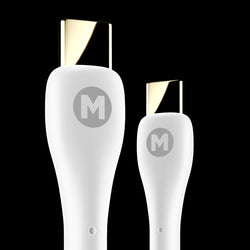
What is a GaN Charger and Why Should You Buy One?
You may just look at a charger and think, it’s a charger – nothing more, nothing less. You connect your device, plug the charger in and your cellphone, tablet or gaming device gets filled up with power ready to give you a day full of connectivity.
You may even own a GaN charger and not be aware of it. Let’s find out more about what they do and why they could well be the charger type you need to stay better connected.
What is a GaN charger?
A GaN (or Gallium Nitrate charger) is a charger or power brick that makes use of a tech innovation that is seeing traditional chargers, that use silicon, being phased out by smaller, more efficient devices that disregard silicon as a key material. The use of the GaN material means that less heat is produced and, therefore, the components are placed closer together when the product is assembled. This results in a smaller charging device but one that gives the same results and safety standards as those that the previous devices would have achieved. That being said, chargers using silicon are still very much on the market.
What is GaN?
GaN (Gallium Nitrate) is a material that is helping change the charging world. Being a material that allows for smaller, more efficient devices to be made, GaN chargers like MAGFAST Wall are seen as largely advantageous and are likely to be utilized in a wide variety of tech products going forward.
Before GaN technology was developed, the world of charging, and in fact the world of many tech devices, relied on silicon for the creation of transistors and much more. Silicon was found to conduct electricity much better than the materials used previously and was adopted as the perfect replacement for the older tech. As with anything, progression is always inevitable and the implementation of GaN meant that silicon was likely to be phased out. Although we haven’t yet reached that stage, many companies are still spending vast sums of cash on building the devices of yesterday rather than looking to the future. Cheaper to build, therefore cheaper to sell, just as efficient and safer, it’s a no-brainer, right?
GaN was originally introduced in the 1990s where it was, and has since remained, an important part in the manufacture of LEDs. Also used in satellites for solar cells and in Blu-ray players, GaN has been seen as the material that could help revolutionize certain elements of tech advancement. Its use allows things to be smaller yet still retain, or even improve upon, the quality of similar products manufactured before GaN was introduced.
In 2006, GaN transistors were being produced en masse as more tech brands looked to utilise them.
Why is GaN better than silicon?
We have already mentioned how Gallium Nitrate allows for the production of smaller devices, but that’s not the only reason why we’re seeing more and more manufacturers of high-quality tech turn to it. One of the main benefits, when compared directly to the products that use silicon, is power efficiency. It has been discovered that GaN is capable of conducting electrons 1,000 times more efficiently than silicon does. Factor in the lower manufacturing costs and it stands to reason that many tech companies are heading down this route.
As mentioned before, the other advantages of GaN chargers when compared to non-GaN products are many. In case you missed it, check the list of what we think are the key ones here:
- smaller chargers
- able to charge faster
- can handle higher temperatures
- more cost-effective
Also, it’s worth bearing in mind that silicon has, in essence, reached the end, or is at least approaching the end, of being improved upon. The demands put upon manufacturers to be environmentally compliant and the efficiency requirements consumers seek mean that silicon conductors are not able to keep up with current or future demands.
If we wanted to get truly technical, we can look at what is known as the bandgap. This will help explain another reason why these products can be built smaller than those relying on silicon.
What is a bandgap?
All materials that act as semi-conductors have a bandgap. This is somewhere, in a solid item, where electrons cease to exist. Therefore, the bandgap relates to how well that solid item can conduct electricity. When comparing silicon to GaN, the results show that Gallium Nitrate has a wider bandgap meaning that it can sustain higher levels of voltage and higher temperatures than silicon.
Having a higher bandgap than silicon also means that the flow of electricity can pass faster through a GaN chip than it could a silicon one. This allows for faster processes and, therefore, a faster charge.
Can I use a Gan Charger with multiple devices?
With GaN chargers being smaller than those that need silicon components, they can rely on USB-C power distribution. This is beneficial to many as USB-C delivers a fast charge. Studies find that chargers with USB-C power delivery can charge a device by as much as 70% faster than a standard charger.
With tech evolving at such speed in both chargers and the devices that need them, you’ll be pleased to know that many bits of kit you own may support the faster USB-C method of power delivery. If you own an iPhone 8 or above, your iPhone will take advantage of this technology, meaning you can benefit from a fast charging power bank rather than a more sluggish product for your charging needs. If you are an Android user, a huge number of phones using this operating system have incorporated USB-C too, allowing for GaN chargers to be of huge benefit when you need a power boost. Many laptops and tablets have also gone down this route, meaning that the vast majority of your tech can be charged quicker.
If your device does support USB-C power delivery, just ensure you have the correct USB-C cable as well as charger. You can always consult your user manual to see information relating to the power delivery of your device.
How much faster will a GaN charger be compared to others?
The speed of charge is something well worth shouting about – tests have shown that, due to how they are made and what they are made of, GaN chargers can get your tech charged by as much as 20 times quicker than the silicon equivalents. This is largely due to them delivering as much as three times more power.
Are GaN chargers available?
Despite many tech devices utilizing USB-C power delivery, the number of GaN chargers that harness the benefits of USB-C PD on the market is still relatively small and it is only companies like MAGFAST that are truly opening the doors to what many see as the only way future charging devices will be able to be constructed and, as a result, sold. As we mentioned earlier, the benefits are huge, not only to the consumer but also to the manufacturer
Are GaN chargers the future?
In our opinion yes – because they can handle higher voltages and higher temperatures than other charging devices, they are seen as safer and more reliable. Furthermore, due to the benefit of the bandgap, they can be made smaller than chargers that rely on silicon. This is always handy, especially when you are packing luggage or trying to utilise space. For manufacturers, and for the consumer, the fact GaN chargers also require fewer parts to make them means a cost saving can also be seen by both parties.
At MAGFAST, we know how important it is to remain connected and that is why our family of chargers are leading the way in keeping you full of power when you need to be. Take MAGFAST Wall for example, a charger that benefits from USB-C power delivery and harnesses the benefit of GaN. Want to know just how good they are? Check out our demo, you might just win $1,000 of high-level tech gear! With MAGFAST, not only are you benefitting yourself with revolutionary new tech, but you also help us make the world a greener place. Every purchase sees a tree planted and with over 500,000 planted so far, we aren’t just changing charging for good, but the world too!
America's highest-rated smart phone cable ...



